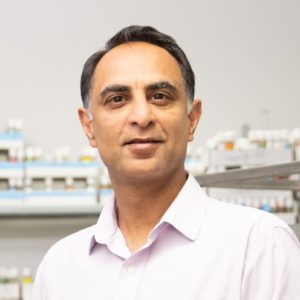The Buck Institute for Research on Aging Sites AGEs as Drivers of Age-Related Disease
An inevitable by-product of metabolism, advanced glycation end products (AGEs) are toxic molecules formed when proteins, DNA and fats become bound after exposure to sugar. They are also in some of the foods we eat.
 Pankaj Kapahi thinks the research community has neglected the importance of AGEs because they are challenging to study. Now he is on a mission to get scientists to focus on them as a driver of many age-related diseases. The Buck professor makes his case in a review article recently published in the journal Cell Metabolism; the work also gives us good reason to avoid foods that contain AGEs. (More on food later, but for now, try to hold off on the barbequed ribs.)
Pankaj Kapahi thinks the research community has neglected the importance of AGEs because they are challenging to study. Now he is on a mission to get scientists to focus on them as a driver of many age-related diseases. The Buck professor makes his case in a review article recently published in the journal Cell Metabolism; the work also gives us good reason to avoid foods that contain AGEs. (More on food later, but for now, try to hold off on the barbequed ribs.)
AGEs affect nearly every cell type and our bodies have inherent defense mechanisms that can clear them. But the production of AGEs really ramps up when blood sugar is high, and eating a typical high-carbohydrate, highly processed Western diet can overwhelm those natural defenses. Further, some of us are likely to be genetically prone to develop more of them, no matter what we eat.
AGEs and disease
AGEs make our cells old before their time, and over time the molecules accumulate in our tissues. The AGEs cause chronic inflammation, make proteins lose their shape, and send our metabolism into a sugar burning state, making it hard to lose weight. To make matters worse, the molecular damage from AGEs is irreversible.
AGEs contribute to obesity and metabolic syndrome. They’ve long been implicated in insulin-resistant type 2 diabetes (which affects more than 29 million people in the U.S.) and are linked to its complications – diabetic nerve pain, retinopathy, cardiomyopathy, and kidney disease. In addition, AGEs are now seen as potential players in neurodegeneration. Recent findings associate AGEs with familial, early-onset and sporadic forms of Parkinson’s disease, and with proteins linked to Alzheimer’s disease. In one study, plaques extracted (post-mortem) from brains of patients with Alzheimer’s show a 3-fold increase in AGEs content compared to age-matched individuals who died from other causes. AGEs are even found in cataracts.
Knowing what we know now, it seems almost quaint that science once viewed AGEs as a phenomena similar to wrinkles – they just happened and were considered mysterious and mostly inconsequential.
Kapahi is determined to give AGEs their rightful place in research on aging. “When you’re looking at a biological process that impacts so many diseases you know you’re onto something interesting,” he said. “That’s why I’m excited. That’s why we took the effort to write the review.”
The challenges and opportunities for researchers
The chemistry behind the formation of AGES was discovered in 1912and an AGEs-based theory of aging was proposed more than three decades ago. Kapahi says interest in the then red-hot field flagged when a drug designed to clear AGEs in diabetic kidney disease failed in clinical trials in 1998. “Previous research focused on addressing AGEs outside of the cell, in the blood and in serum. The problem is much bigger when AGEs go into the cells, that’s where we need to focus the attention.”
But it’s nearly impossible to study the biological development of AGEs and their implications in humans because they take decades to accumulate and there are obvious ethical concerns in encouraging the development of the toxic molecules in test subjects. So how to get researchers excited about understanding and exploiting the biology of AGEs? Kapahi says the way to get at the pathways involved in AGEs lies in simple animals including yeast, nematode worms, and flies. “We can model the diseases in these animals. Rather than waiting 30 years to see what happens in a human, we can see AGEs in nematode worms in two weeks,” he said.
C. elegans are used to study the effects of AGEs
Alejandro Gugliucci, a professor of Biochemistry and Associate Dean of Research at Touro University California co-authored the review. He is an expert on the bad effects of sugar, particularly fructose which is used to sweeten many processed foods and beverages. Even though he works on efforts to study and stem sugar consumption in humans, he echoes Kapahi’s enthusiasm for basic research in simple animals. “It’s the best way to get at the genetics and the biology behind AGEs. It’s the best way to screen compounds that could quash them,” he said. “If it doesn’t work in simple animals, it’s not going to work in humans. That’s where we need to start.”
Promising results from the Kapahi lab
Scientists in the Kapahi lab have found a sensor related to AGEs and the complications of diabetes in the nematode C. elegans. Publishing in Current Biology they identified two natural compounds which prevented nerve damage in worms experiencing a similar hypersensitivity to touch as do humans who suffer from diabetic neuropathy. AGEs have also been implicated in neuropathy in mice and humans. “The worm findings gave us a pathway to study many of the ravages of type 2 diabetes, I’m sure there are others,” said Kapahi.
The lab is also working on a project exploring a link between diabetes and Parkinson’s disease. Researchers identified a gene that produces an enzyme that detoxifies the highly reactive compounds that cause AGEs. Mutations in the gene are linked to a familial form of Parkinson’s. “The hope is to develop a new treatment for Parkinson’s,” said Kapahi. “The research also holds the tantalizing possibility that compounds that target this gene could be valuable in treating a number of age-related diseases.”
Okay, but what about AGEs in food? What do we eat?
If yo u want to see the effect of sugar binding with proteins and fats, look into your frying pan. The brown crust on grilled or pan-seared red meat is pure AGEs. Kapahi urges people to avoid cooking with dry heat, opting instead for steaming, stewing, poaching and braising. Frying with oil isn’t great either. According to the American Diabetes Association (ADA), fried chicken has more than six times the amount of AGEs when compared to a same-size serving of boiled chicken.
u want to see the effect of sugar binding with proteins and fats, look into your frying pan. The brown crust on grilled or pan-seared red meat is pure AGEs. Kapahi urges people to avoid cooking with dry heat, opting instead for steaming, stewing, poaching and braising. Frying with oil isn’t great either. According to the American Diabetes Association (ADA), fried chicken has more than six times the amount of AGEs when compared to a same-size serving of boiled chicken.
Boiled grains and sandwich breads are low in AGE’s but ADA experts say AGEs content can soar when those grains are processed into crispy brown crackers or sugar-sweetened cookies. Milk and yogurt are low in AGEs, but when moisture is removed and fat is concentrated (butter and cheese) the AGEs content rises dramatically. For those with an insatiable hankering for grilled foods, the ADA recommends throwing fruits and vegetables on the grill. You’ll still get some AGEs, but in a small amount compared with grilled meats.
“Unfortunately AGEs taste great, even the worms and flies prefer them when they have an option,” says Kapahi, who often gets good-naturedly labeled as a killjoy at neighborhood parties. “Overall I think it’s good to follow a Mediterranean-type diet with lots of vegetables and whole grains with small portions of meat or other proteins.”
Thanks to the Buck Impact Circle
The Buck Impact Circle, a donor group that pools its resources to support collaborative early-stage research at the Institute, has chosen to fund many projects involving the Kapahi lab. In addition to supporting research on the complications of diabetes and the link between AGEs and Parkinson’s disease, the group has also funded projects aimed at determining if a ketogenic diet can protect against the complications of diabetes. This year they put their money toward research that tests compounds that show promise in lowering AGES associated with Alzheimer’s disease pathology.
“I am extremely grateful to the Impact Circle for their support and encouragement,” says Kapahi. “Being able to interact directly with these donors is so personally rewarding, it helps remind everyone in the lab that our work is really focused on human health.”
“It has been such a joy and privilege to follow Pankaj’s research and to support his progress,” said Buck Institute trustee Bob Griswold. He and his wife Alex are founding members of the Impact Circle. “Belonging to this group is exciting and educational. Nothing compares to having a personal investment in work aimed at helping us all live better longer.”
Next steps in the research
AGEs are a group of compounds that include more than 20 different targets. Kapahi says there is a lot of work for researchers to tackle and he’s happy to talk to anyone interested in the field.
Touro’s Gugliucci is particularly excited about collaborating with Kapahi to work on compounds that enhance our natural defenses against the formation of AGEs. “This is the way to go, to prevent the formation of AGEs in the first place” he said. “I think there’s a good chance that we’ll be able to get NIH funding to move the work forward into mammals and ultimately humans.”
Kapahi says there are many questions that need answers. Why do some people get AGEs-associated diabetic complications even before they develop full-blown diabetes? Does aging affect the body’s efforts to detoxify AGEs and can we address the problem from that angle? What are the different mechanisms to detoxify AGEs? How do our genetics influence AGEs accumulation and detoxification? Can we make compounds that slow the progression of AGEs accumulation? What diseases can they help treat?
Finally, Kapahi wants you to remember that he’s happy to talk about the research and be on the stump for AGEs. Just be sure there’s a friendly, open-minded crowd when you invite him to dinner.


